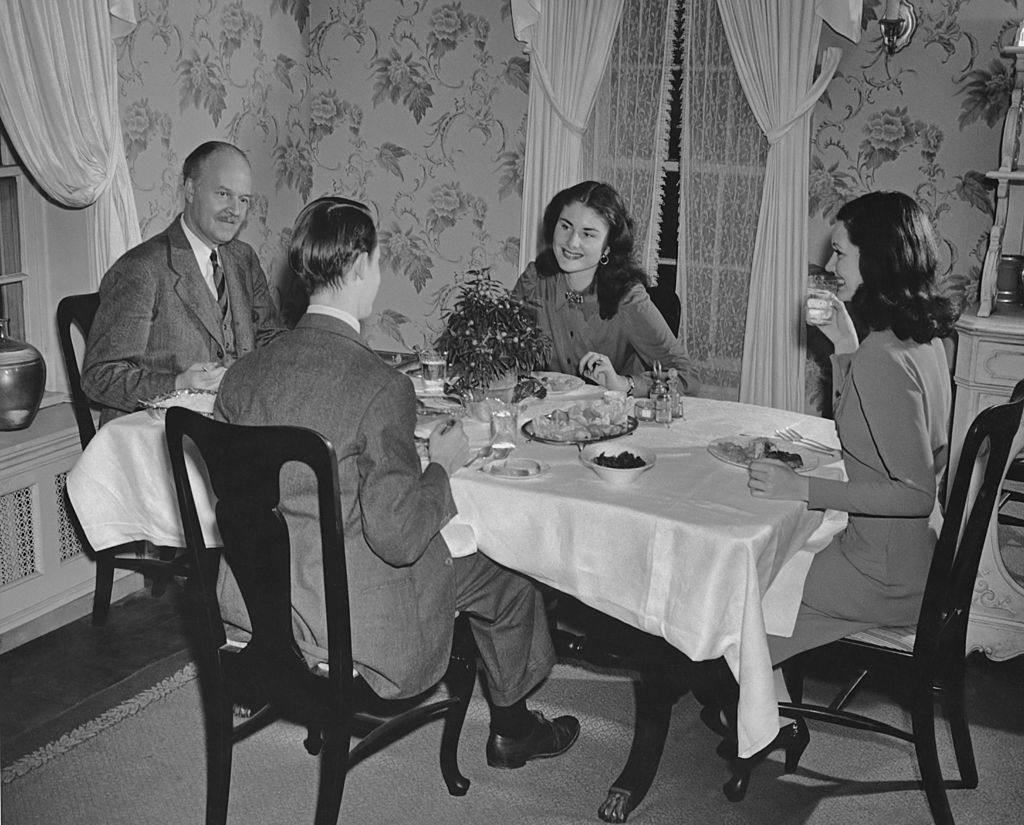I grew up in rural Connecticut, in a remodeled cow barn where my family sat at an antique hutch table for meals. The table with four comfortable Windsor chairs fit into a niche. My sister Christina and I weren’t allowed to join my parents for dinner at the table until we could hold a conversation. For me, that was at five.
The rule came from my father, as that was how he’d been brought up. Once, when we were in our early teens, I whispered to Christina, “It’s King Arthur’s round table” — our father’s middle name was Arthur. I must have learned some British history and was probably showing off.
My firm but gracious father wasn’t a king. But I certainly saw him as a knight in shining armor when he recounted stories and helped my mother teach us table manners — to be polite and well-spoken, and to express ourselves properly without hurting feelings or being rude, especially around the family dining table. My father considered table talk a fine art. As we matured Christina and I learned how to listen and discuss the issues of the day without undue emotion or rancor. Opinions were always welcome at the table, if they were civil and based on fact.
In his late twenties, my father bought the table and chairs in a Manhattan secondhand shop. He paid $10 for the furniture; his starting weekly salary as an art director was $35. I can only imagine the conversations around the table back then; it was an exciting time to be a bachelor in New York. I remember my father recounting how he’d met my Swedish mother at the Skål Club, on lower Fifth Avenue.
My parents were married in 1936, three months later. They stayed in the apartment until moving to a bigger one on Sutton Place. They brought the table with them. It then moved to the New York suburbs after I was born in 1943. When Pearl Harbor was attacked, my father volunteered to join the Office of War Information as a war correspondent in China, Burma and India. There were crucial table conversations between my parents as they discussed what my mother should do if my father was killed.
While my father was overseas, my mother asked her parents to come out from the city and help care for me and Christina. Christina and I learned baby Swedish at the table. When my father returned, Swedish stopped as he couldn’t participate. But the table heard Burmese and the click of chopsticks as my father taught his family and guests how to use them.
The table moved to the barn in Weston in 1947. My father’s imagination, skill and ability to solve problems built much of the unusual home. Postwar suburban Connecticut had few houses on the market. Christina and I ate dinner on bar stools at the mahogany bar my father built between the open kitchen and dining niche. My parents wanted us to listen to adult conversations and stories and learn.
Among my parents’ friends were writers, artists, even a silent-screen actress who chatted excitedly when she recounted her fabulous Hollywood tales. I was too young to appreciate the sophisticated conversations. But I remember lots of laughter, not raised rhetoric. I learned how to make conversation flow seamlessly, include all those at the table in conversations and how to avoid unpalatable subjects, gracefully. Lately, I’ve been able to rely on that early education to get through some dicey moments with family and guests.
My mother added two more Windsor chairs to the table as their social circle grew. The table was featured in the Women’s Home Companion magazine in 1948, for a story about the unusual remodel, and again, stacked with food and dishes from empty cupboards, on the cover of the Saturday Evening Post in 1953. The magazine promoted wholesome, American family life centering around meals. Stevan Dohanos, who often did covers featuring neighboring Westport, was asked to portray a harassed young married couple. My father, dressed in his business suit, hurriedly devours the newspaper and breakfast, cooked by my mother in her bathrobe and hair curlers. Unknowingly, my parents were playing a part in a rapidly disappearing American scene: families conversing civilly around a table.
As grandchildren were added to the family, my mother changed the hutch to a farm table to seat the expanding family. The hutch went to the summer house on Cape Cod, where it heard lively conversations and much laughter from grandparents, parents and five grandchildren relating beach, tennis and golf stories. It heard groans of gustatory joy as the family ate lobsters, clams and mussels and giggles of delight when my mother made pläta, lacy-thin Swedish pancakes, for breakfast. There were oohs and aahs when my father made his sumptuous, fluffy Sunday cheese omelets with his garden’s tomatoes and chives.
After my father died in 1984, the table moved down the road to a nook overlooking the Mill Pond in my mother’s granny annex at our summer house. After my mother died, the table moved to our first retirement home in Arizona. Much of the table talk was about the beauty of our Far West and how different were winters on the East Coast, and in Switzerland and Belgium, where we had lived with our three children. French was heard at the table after our youngest daughter fell in love with a delightful Parisian.
Now the table sits in our garage. My mother left it to our son, hoping it be passed down in the family. Perhaps it ruminates, as do I, about three centuries of table talk beginning with an early American family, before a roaring fire.
This article was originally published in The Spectator’s April 2022 World edition.

























